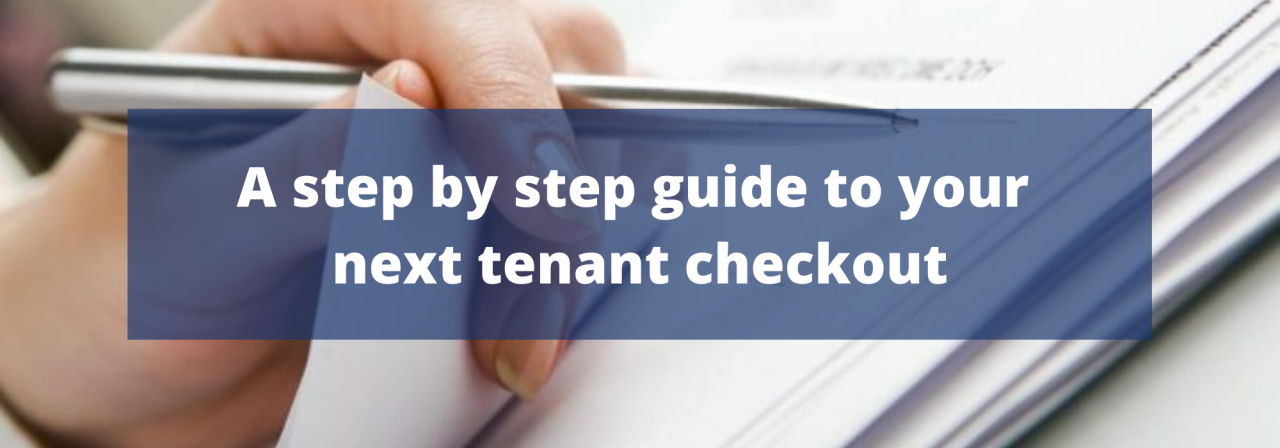When it’s time for a tenant to move out, you want the process to go as smoothly as possible so new tenants can be moved in quickly and comfortably.
Much of the move-out process is about ensuring the previous tenant adheres to the contract and leaves you with as little to do as possible. While you obviously can’t control everything, a clear process coupled with frequent communication helps your tenants do their part and ensure everything goes smoothly. You don’t want to be left responsible for removing old furniture or fixing broken items once you’ve returned the deposit.
Run this checklist every time a tenant is moving out to prepare the property for the next tenant while making sure you do not incur any lost revenue or have to face a messy legal situation.
The Check-out
Ensure adequate notice has been given by the tenant
The tenant should provide you with a written notice to move out. This should clearly state the reason for moving out and a specific date for when it will take place. The date they select must give you enough notice as stated in the lease agreement.
Property inspection
Once the move-out date has been confirmed, conduct a walk-through inspection of the property to document any damage as well as cleaning and general maintenance needs.
This is also an essential step in evaluating what portion (if not all) of the security deposit will be paid back to the tenant once they have vacated.
Keep in mind that some things need to be checked in every room, while others are unique to specific rooms. For example, you will obviously only need to inspect a stove in the kitchen, whereas flooring, walls, doors, locks and windows will need to be inspected in all rooms.
Send email to schedule inspection
Contact the tenant to schedule an inspection date for you to evaluate the overall condition of the property.
The Inspection - Plumbing
Drains – Run the taps from all water outlets in the house for several minutes to ensure there are no overspills from the drains. It’s also worth removing the drain covers and ensuring there are no obvious and visible blockages.
Taps – Check all taps actually work and water flows as it should. Don’t neglect outside/garden taps.
Plug holes – Ensure plug-holes are thoroughly cleaned by your tenant; removing any excess hair or blockages.
- Water pressure / flow – If there are any blocked pipes, it may have an impact on the water flow. So check the pressure and flow from all taps is as it should be. Blocked pipes commonly occur from substances being wrongly disposed of down the sink. If that’s the case, the responsibility should fall onto the tenant.
Electrics
White goods / Electrical Items – Don’t rely on visual inspections, ensure each item is tested and in full working order. Pay particular attention to the cleanliness of the items, especially the white goods.
Oven - The oven is often overlooked by tenants which could result in a professional clean being required. Make sure to thoroughly check inside and behind.
Appliances – Check all other appliances you provided. If there are additional ones that the tenant has purchased, consider whether it needs to be removed or not.
Plug points – Check to see all plug points are working. Additionally, check plastic plug socket covers aren’t broken/cracked. Plug socket covers often get broken when furniture is being moved around.
Light Switches – Ensure all light switches work, also checking that the actual switches are in good condition.
Doorbell – Check to see if it still works.
Fire / Smoke Alarms – Check all fire alarms are in working order.
Fittings
Doors – Ensure all doors open, close and lock properly. It’s also worth looking for significant cracks/splits in the doors, especially where the lock is. Doors can be expensive to replace.
Windows – ensure all windows open, close and lock. Also look for any chips and/or cracks.
Laminate/hardwood flooring – if you have laminate/hardwood flooring, check for breaks, chips and unevenness.
Sinks / baths/ showers – check all ceramic and plastic fittings for cracks and chips.
Storage
Outside/Inside Bins– always check that the bins are completely empty. It should be the tenant’s responsibility to dispose of all rubbish before they vacate the property.
Cupboards / Drawers– Make sure cupboards and drawers are completely empty.
Shed / Garage – ensure all items from outbuildings are removed. Also worth checking the fittings in the outbuildings e.g. doors, windows, locks.
Loft / Attic – check the loft/attic is empty and doesn’t contain any of the tenant’s unwanted items.
Furniture
Underneath / behind – Check around, under, behind, on top, and inside of the furniture to ensure it is as it should be.
Testing – give each furniture piece a test of stability and usability e.g. lay down on the beds and sit down on the sofas. Make sure everything feels safe and sturdy.
Unwanted furniture removed – tenants often buy temporary furniture with the intention of leaving them behind when it’s time to vacate. The tenant may suggest leaving the items in the property for your new tenants, however, it’s a good idea to make them remove the item as you will become responsible for it once they have left.
Security / Alarms
Alarm – check the alarm is still working, specifically the sensors.
Unlock key – check that the intruder switch is still operable and the unlock key for it is present.
Alarm code – check that the original alarm code is still the same (i.e. the tenants didn’t change it).
Don’t Forget
Obtain a forwarding address
Make sure the tenant provides you with a forwarding address so you can return their deposit and forward their mail. If you are dealing with a troublesome tenant, not having a forwarding address is a problem. They may leave the property in such poor condition their security deposit cannot cover the issue and you need to open legal proceedings.
Collect the keys
On the day the tenant is vacating, be very clear about where you would like them to leave/drop off the keys. This should be stated in clear communications along with a description of the penalty if they fail to return the keys within a certain timeframe.
If you have tenants about to move out or you need any advice about your property, speak to your local letting agent today.


 By
By 
 By
By 


 By
By
Share this with
Email
Facebook
Messenger
Twitter
Pinterest
LinkedIn
Copy this link